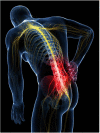Defining the Patient with Lumbar Discogenic Pain: Real-World Implications for Diagnosis and Effective Clinical Management
- PMID: 37240991
- PMCID: PMC10224560
- DOI: 10.3390/jpm13050821
Defining the Patient with Lumbar Discogenic Pain: Real-World Implications for Diagnosis and Effective Clinical Management
Abstract
There is an enormous body of literature that has identified the intervertebral disc as a potent pain generator. However, with regard to lumbar degenerative disc disease, the specific diagnostic criteria lack clarity and fail to capture the primary components which include axial midline low back pain with or without non-radicular/non-sciatic referred leg pain in a sclerotomal distribution. In fact, there is no specific ICD-10-CM diagnostic code to classify and define discogenic pain as a unique source of pain distinct from other recognized sources of chronic low back pain including facetogenic, neurocompressive including herniation and/or stenosis, sacroiliac, vertebrogenic, and psychogenic. All of these other sources have well-defined ICD-10-CM codes. Corresponding codes for discogenic pain remain absent from the diagnostic coding vernacular. The International Society for the Advancement of Spine Surgery (ISASS) has proposed a modernization of ICD-10-CM codes to specifically define pain associated with lumbar and lumbosacral degenerative disc disease. The proposed codes would also allow the pain to be characterized by location: lumbar region only, leg only, or both. Successful implementation of these codes would benefit both physicians and payers in distinguishing, tracking, and improving algorithms and treatments for discogenic pain associated with intervertebral disc degeneration.
Keywords: diagnosis; discogenic; lumbar; pain; referred; reimbursement.
Conflict of interest statement
M.P.L. and J.E.B. are independent advisors to Vivex (Vivex Biologics, Miami, FL USA). J.E.B. received remuneration for manuscript development. M.P.L., D.P.B., A.K.C., K.-U.L. and N.M. received no funding for this study and report no other conflicts of interest.
Figures




References
-
- Alini M., Diwan A.D., Erwin W.M., Little C.B., Melrose J. An update on animal models of intervertebral disc degeneration and low back pain: Exploring the potential of artificial intelligence to improve research analysis and development of prospective therapeutics. JOR Spine. 2023;6:e1230. doi: 10.1002/jsp2.1230. - DOI - PMC - PubMed
LinkOut - more resources
Full Text Sources

